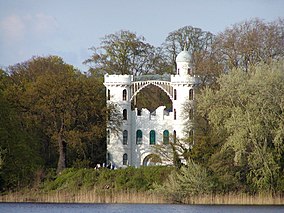Pfaueninsel
| Pfaueninsel | |
|---|---|

View of the Castle from the Havel.
|
|
| Location | Berlin |
| Coordinates | 52°26′4″N 13°7′51″E / 52.43444°N 13.13083°ECoordinates: 52°26′4″N 13°7′51″E / 52.43444°N 13.13083°E |
| Area | 67 hectares |
| Established | originally in 1924 |
| Governing body | Stiftung Preußische Schlösser und Gärten Berlin-Brandenburg (SPSG) |
| World Heritage Site | Palaces and Parks of Potsdam and Berlin |
| http://www.spsg.de/schloesser-gaerten/objekt/pfaueninsel/ | |
| Palaces and Parks of Potsdam and Berlin | |
|---|---|
| Name as inscribed on the World Heritage List | |
| Location | Germany |
| Type | Cultural |
| Criteria | i, ii, iv |
| Reference | 532 |
| UNESCO region | Europe and North America |
| Inscription history | |
| Inscription | 1990 (extended in 1992 and 1999) (14th Session) |
Pfaueninsel ("Peacock Island") is an island in the River Havel situated in Berlin-Wannsee, in southwestern Berlin, near the border with Potsdam and Brandenburg. The island is part of the Palaces and Parks of Potsdam and Berlin UNESCO World Heritage Site and a popular destination for day-trippers. Pfaueninsel is also a nature reserve in accordance with the EU Habitats Directive and a Special Protection Area for wild birds.
Pfaueninsel is an island of 67 hectares in the river Havel between the Großer Wannsee and the Jungfernsee near Berlin, Germany. It is mostly woodland with some open areas, including lawns and fields. The total size of the protected area, including some water-covered areas, is 98 hectares.
In the late 17th century the island was called Kaninchenwerder ("Rabbit Island") after a rabbit breeding station set up by Elector Frederick William I of Brandenburg of the Hohenzollern dynasty. From 1685, he gave the chemist Johann Kunckel financial aid to build a glass foundry in the east of the island, the whole of which became Kunckel's property. Here Kunckel discovered a process to produce artificial ruby (red) glass. After the elector's death in 1688, however, Kunckel gained no further support from Frederick William's heir. In 1689, the foundry was destroyed by a fire (possibly caused by arson), and Kunckel left in 1692 for to work for the King of Sweden.
The island remained unused for about 100 years until, in 1793, the Prussian king Frederick William II, a descendant of Frederick William I, acquired the island and had the Pfaueninsel castle built for himself and his mistress Wilhelmine Enke in 1794-1797. The small Lustschloss was placed on the western tip of the island, visible from the king's residence at the Marmorpalais in Potsdam. It was designed as a summer residence for the King by Johann Gottlieb Brendel. Around it an English garden was created, including a dairy shaped like a gothic revival church on the other end of the island. One of the garden designers was Johann August Eyserbeck who died in 1801. In 1804, Ferdinand Fintelmann took over as royal gardener.
...
Wikipedia

